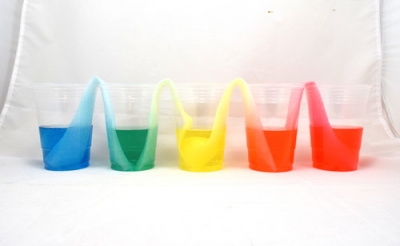
What you need:
Paper towels, three glasses, tood colours or poster colours.
What to do:
1. Arrange the three glasses in a row.
2. Fill the glasses on both ends with water, leaving the middle one empty.
3. Add lots of blue colour to the glass on the left, and add yellow to the glass on the right.
4. Fold one of the tissues in half lengthwise and place one end in the first glass and the other end in the second. Make sure the tissue touches the bottoms of both glasses without having its middle stuck up too high in the air. If that happens, you can trim the length of the tissues.
5. The next tissue is placed in a similar manner between the second and the third glasses.
6. Leave the arrangement, but make sure to keep checking on it intermittently.
What happens?
In a few minutes, we start seeing the coloured water from both the glasses on the edge, climb up the tissue papers. In an hour (maybe more, depending on the thickness of the tissues), the water crosses the paper bridge and starts dripping into the empty glass. In another hour or so, the water level in the middle glass rises as more water from the other two glasses crosses into it. The water in the middle glass is greenish a mix of yellow and blue colours. Why? Water travels up the tissues through a process called ‘capillary action.
Capillary action is the movement of a liquid against gravity, through narrow spaces. This is the same principle that allows water to be absorbed by a tree’s roots and transported to its leaves. In this case, the narrow spaces or capillaries are present in the tissues that absorb water, pull it upward and allow it to flow into the middle glass.
Picture Credit : Google




